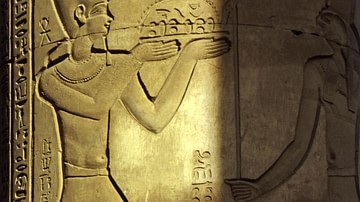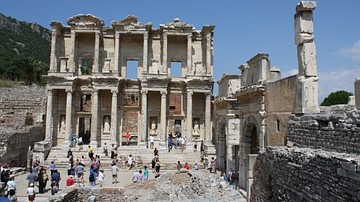Once the largest library in the ancient world, and containing works by the greatest thinkers and writers of antiquity, including Homer, Plato, Socrates and many more, the Library of Alexandria, northern Egypt, is popularly believed to have been destroyed in a huge fire around 2000 years ago and its volumous works lost.
Since its destruction this wonder of the ancient world has haunted the imagination of poets, historians, travellers and scholars, who have lamented the tragic loss of knowledge and literature. Today, the idea of a 'Universal Library' situated in a city celebrated as the centre of learning in the ancient world, has attained mythical status.
The mystery has been perpetuated by the fact that no architectural remains or archaeological finds that can definitely be attributed to the ancient Library have ever been recovered, surprising for such a supposedly renowned and imposing structure. This lack of physical proof has even persuaded some to wonder if the fabulous Library actually existed at all in the form popularly imagined.
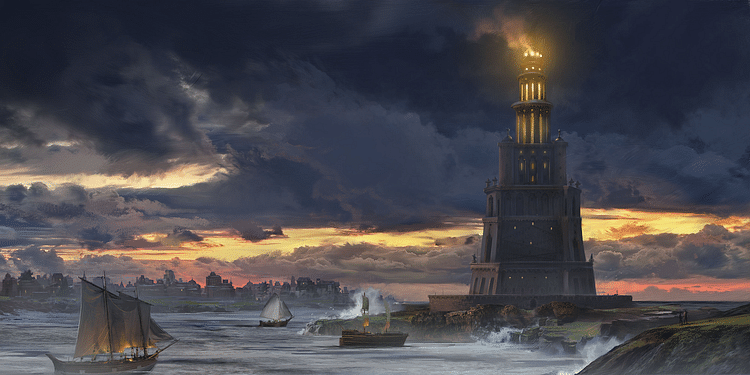
Ancient Alexandria
Once home to the massive Pharos lighthouse, one of the Seven Wonders of the Ancient World, the Mediterranean seaport of Alexandria was founded by Alexander the Great around 330 BCE, and like many other cities in his Empire, took its name from him. After his death in 323 BCE, Alexander's Empire was left in the hands of his generals, with Ptolemy I Soter taking Egypt and making Alexandria his capital in 320 BCE. Formerly a small fishing village on the Nile delta, Alexandria became the seat of the Ptolemaic rulers of Egypt and developed into a great intellectual and cultural centre, perhaps the greatest city in the ancient world.
The Origins of the Ancient Library
The founding of the Library of Alexandria, actually two or more libraries, is obscure. It is believed that around 295 BCE, the scholar and orator Demetrius of Phalerum, an exiled governor of Athens, convinced Ptolemy I Soter to establish the Library. Demetrius envisioned a library that would house a copy of every book in the world, an institution to rival those of Athens itself. Subsequently, under the patronage of Ptolemy I, Demetrius organised the construction of the 'Temple of the Muses' or 'the Musaeum', from where our word 'museum' is derived. This structure was a shrine complex modeled on the Lyceum of Aristotle in Athens, a centre for intellectual and philosophical lectures and discussion.
The Temple of the Muses was to be the first part of the library complex at Alexandria, and was located within the grounds of the Royal Palace, in an area known as the Bruchion or palace quarter, in the Greek district of the city. The Museum was a cult centre with shrines for each of the nine muses, but also functioned as a place of study with lecture areas, laboratories, observatories, botanical gardens, a zoo, living quarters, and dining halls, as well as the Library itself. A priest chosen by Ptolemy I himself was the administrator of the Museum, and there was also a separate Librarian in charge of the manuscript collection. At some time during his reign from 282 BCE to 246 BCE, Ptolemy II Philadelphus, the son of Ptolemy I Soter, established the 'Royal Library' to complement the Temple of the Muses set up by his father.
It is not clear whether the Royal Library, which was to become the main manuscript Library, was a separate building located next to the Museum or was an extension of it. However, the consensus of opinion is that the Royal Library did form part of the Temple of the Muses.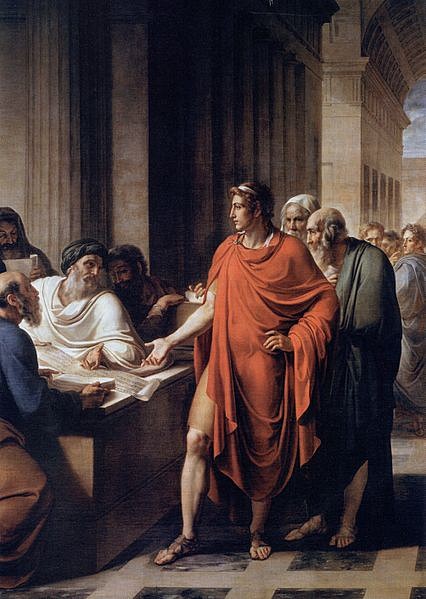
One story goes that the hunger of Ptolemy III for knowledge was so great that he decreed that all ships docking at the port should surrender their manuscripts to the authorities. Copies were then made by official scribes and delivered to the original owners, the originals being filed away in the Library.
An often quoted figure for the ancient Library holdings at its peak is half a million documents, though whether this refers to the amount of books or the number of papyrus scrolls is unclear. However, in view of the fact that many papyrus rolls were needed to make up an entire book, it is more likely that it refers to the number of scrolls. Even 500,000 scrolls has been thought too high by some scholars, as the construction of a building with such a vast amount of storage space would be an immense, though not impossible undertaking. Nevertheless, during the reign of Ptolemy II the collection at the Royal Library became so vast that a daughter library was established. This library was situated in the precincts of the temple of Serapis, in the Egyptian district of Rhakotis, in the south eastern part of the city. During the librarianship of the Greek writer Callimachus (c. 305 BCE - c . 240 BCE), the daughter library contained 42,800 scrolls, all of which were copies of those in the main Library.
The Burning of the Great Library?
The infamous destruction by fire of the Library of Alexandria, with the consequent loss of the most complete collection of ancient literature ever assembled, has been a point of heated debate for centuries. What exactly happened to this amazing storehouse of ancient knowledge, and who was responsible for its burning? However, it is probable 'the greatest catastrophe of the ancient world', may never have taken place on the scale often supposed.
The prime suspect in destruction of the Library of Alexandria is Julius Caesar. It is alleged that during Caesar's occupation of the city of Alexandria in 48 BCE, he found himself in the Royal Palace, hemmed in by the Egyptian fleet in the harbour. For his own safety he had his men set fire to the Egyptian ships, but the fire got out of control and spread to the parts of the city nearest the shore, which included warehouses, depots and some arsenals.
After Caesar's death it was generally believed that it was he who had destroyed the Library. Roman philosopher and dramatist Seneca, quoting from Livy's History of Rome, written between 63 BCE and 14 CE, says that 40,000 scrolls were destroyed in the fire started by Caesar. Greek historian Plutarch (died 120 CE) mentions that the fire destroyed 'the great Library' and Roman historian Dio Cassius (c. 165 – 235 CE) mentions a warehouse of manuscripts being destroyed during the conflagration.
In his book The Vanished Library, Luciano Canfora interprets the evidence from ancient writers to indicate the destruction of manuscripts stored in warehouses near the port waiting for export, rather than the great Library itself. The great scholar and stoic philosopher Strabo, was working in Alexandria in 20 BC and from his writings it is obvious that the Library was not at that time the world-renowned centre for learning it had been in previous centuries. In fact Strabo does not mention a library as such at all, though he does mention the Museum, which he describes as 'part of the royal palace'. He goes on to say that 'it comprises the covered walk, the exedra or portico, and a great hall in which the learned members of the Museum take their meals in common.'
If the great Library was attached to the Museum then Strabo obviously felt there was no need to mention it separately, and, perhaps more importantly, if he was there in 20 BCE, the Library had obviously not been burned down by Caesar twenty-eight years previously. The existence of the Library in 20 BCE, though in a much less complete form, means that we have to look to someone other than Caesar as the destroyer of Alexandria's ancient wonder.
The last suggested perpetrator of the crime is the Caliph Omar. In 640 CE the Arabs under General Amrou ibn el-Ass, captured Alexandria after a long siege. According to the story, the conquering Arabs heard about a magnificent library containing all the knowledge of the world and were anxious to see it. But the Caliph, unmoved by this vast collection of learning, apparently stated 'they will either contradict the Koran, in which case they are heresy, or they will agree with it, so they are superfluous.'
The manuscripts were then gathered together and used as fuel for the 4,000 bathhouses in the city. In fact there were so many scrolls that they kept the bathhouses of Alexandria heated for six months. These incredible facts were written down 300 years after the supposed event by Christian polymath Gregory Bar Hebraeus (1226-1286 CE). However, while the Arabs may have destroyed a Christian library at Alexandria, it is almost certain that by the mid 7th century CE the Royal Library no longer existed. This is made clear by the fact that no mention is made of such a catastrophic event by contemporary writers such as Christian chronicler John of Nikiou, Byzantine monk and writer John Moschus and Sophronius, Patriarch of Jerusalem.
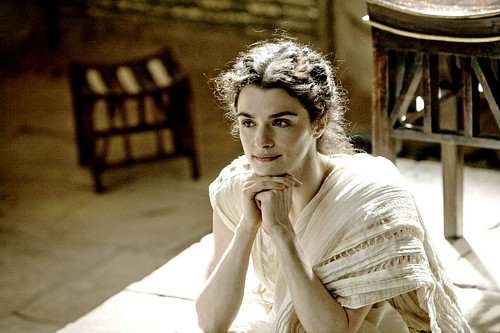
The Volatile City of Alexandria
Attempting to identify one single devastating fire that destroyed the great Library and all of its holdings is a futile task. Alexandria was often a volatile city, especially during the Roman period, as witnessed by Caesar's burning of the ships, and also in the violent struggle between the occupying forces of Queen Zenobia of Palmyra and the Roman emperor Aurelian in 270-71 CE. Aurelian eventually recovered the city for Rome from Queen Zenobia's armies, but not before many parts of Alexandria had been devastated, and the Bruchion district, which contained the palace and the Library, were apparently 'made into a desert'.
The city was again sacked a few years later by Roman Emperor Diocletian. Such repeated destruction spread over several centuries, along with neglect of the Library's contents as people's opinions and affiliations changed, means that the 'catastrophe' that ended the ancient Library at Alexandria was gradual, taking place over a period of four or five hundred years.
The last recorded Director of the great Library was scholar and mathematician Theon (c. 335 - c. 405 CE), father of the female philosopher Hypatia, brutally murdered by a Christian mob in Alexandria in 415 CE. Perhaps one day, in the deserts of Egypt, scrolls that were once part of the great Library will be discovered. Many archaeologists believe that the buildings that once composed the legendary seat of learning at ancient Alexandria, if not buried under the modern metropolis, could still survive relatively intact somewhere in the north-eastern part of the city.



